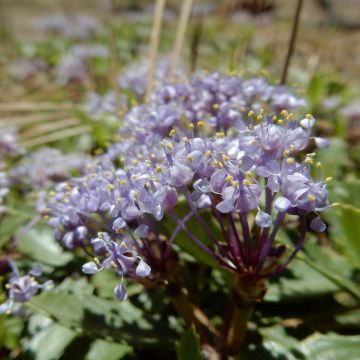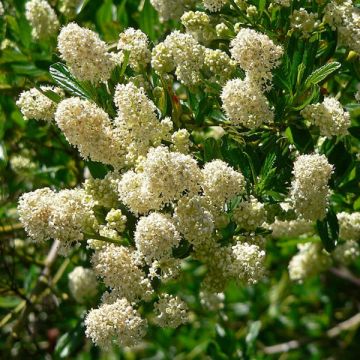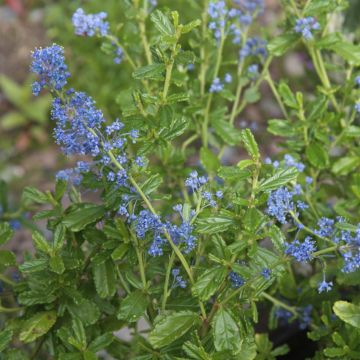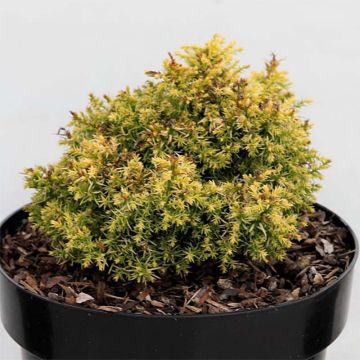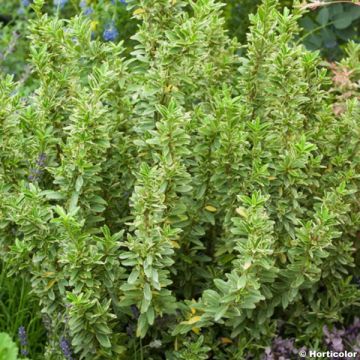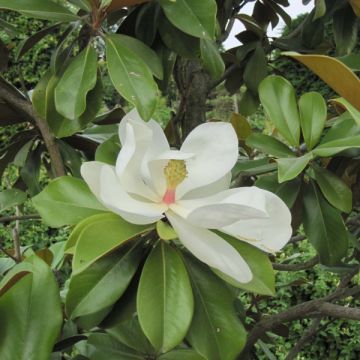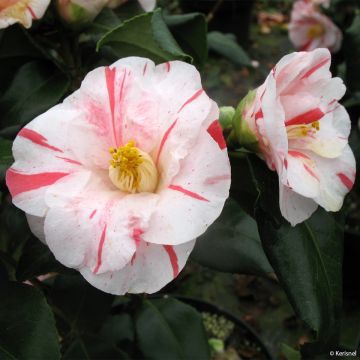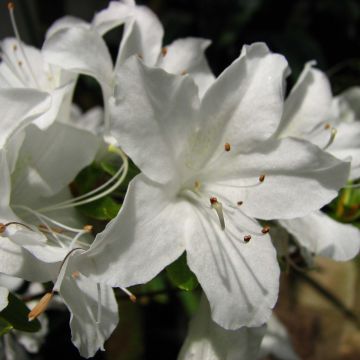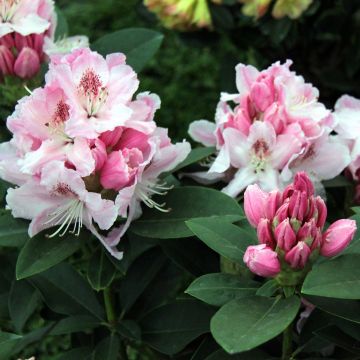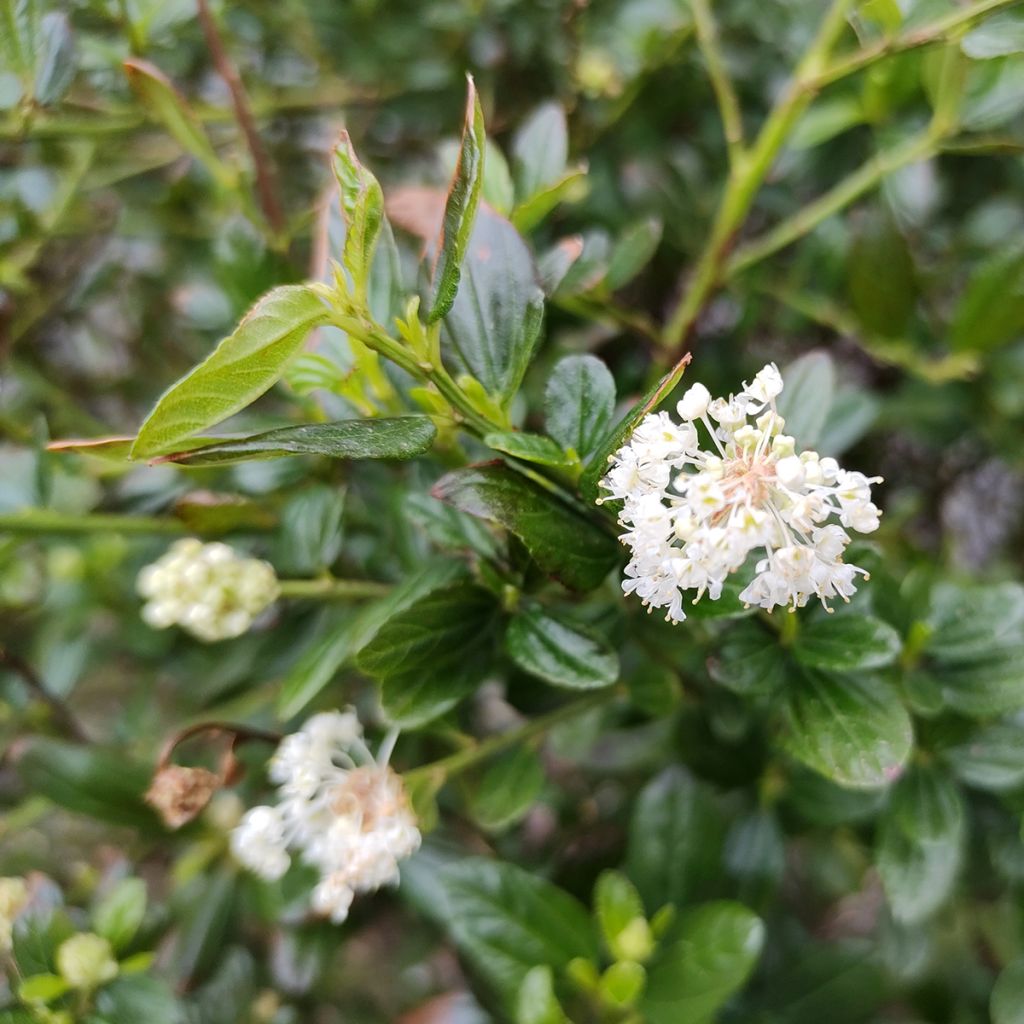

Ceanothus x thyrsiflorus Snow Flurries
Ceanothus x thyrsiflorus Snow Flurries
Ceanothus x thyrsiflorus Snow Flurries
Blue Blossom, Blueblossom, California Lilac
This item cannot be shipped to the selected country
Delivery charge from €5.90
More information
Schedule delivery date,
and select date in basket
This plant carries a 24 months recovery warranty
More information
We guarantee the quality of our plants for a full growing cycle, and will replace at our expense any plant that fails to recover under normal climatic and planting conditions.
From €5.90 for pickup delivery and €6.90 for home delivery
Express home delivery from €8.90.
Does this plant fit my garden?
Set up your Plantfit profile →
Description
The 'Snow Flurries' Ceanothus, sometimes marketed as 'Snow Flurry', is a highly popular variety of California Lilac known for its abundant pure white flowering. The bush forms a beautiful wide mass and is adorned with light green evergreen foliage, which is decorative in all seasons. Its clusters of white flowers, reminiscent of lilacs, are slightly fragrant and attract bees. Evergreen ceanothus has its rightful place in a seaside garden or a not-too-cold climate. This selection thrives in well-drained soils, tolerates summer drought well, and withstands short frosts of around -10°C once mature.
The Snow Flurries Ceanothus is a hybrid horticultural variety that carries the genes of the Ceanothus thyrsiflorus, also known as the blueblossom ceanothus. The latter is a vigorous species native to North America and Mexico, with a variable habit. Hardy down to -10°C, this bush has characteristic angular branches and bears alternate, entire, dentate, leathery leaves with prominent veins. Ceanothus belongs to the Rhamnaceae family and is related to our buckthorn. These shrubs are hosts of chaparral (scrub vegetation) and, once well-rooted, rely on rainwater.
'Snow Flurries' is a large bush that is wider than tall. It is a ramified shrub with a dense habit that can easily reach 1.80m in height and less than 2.20m in width. Depending on the climate, its generous flowering occurs between May and early July. It forms numerous oval clusters of 5-6cm composed of many tiny pure white flowers dusted with stamens. This delicately scented honey-like flowering attracts many pollinators, including butterflies and bees. It is followed by the formation of seeds, which, once mature, are explosively released. Its foliage persists in winter and consists of alternate, ovate-oblong, almost smooth-edged, trinerved leaves, relatively small, about 3-4cm long. They are light green. Ceanothus, which flowers on the previous year's wood, can tolerate very light pruning of faded flowers and troublesome branches just after flowering. Their average lifespan is 15 to 20 years.
The Snow Flurries Ceanothus is a beautiful plant that can be planted in a seaside garden or a drought-tolerant garden in mild regions. It can be placed as a standalone specimen, against a terrace, or in a mixed shrub border with simultaneous or staggered flowering: Fremontodendron californicum (April-May-June), shrubby rockroses, coronillas, 'Mutabilis' China Rose, Crape Myrtle... This variety can also be used in a persistent or mixed hedge, with laurel, photinias, Osmanthus...
Report an error about the product description
Plant habit
Flowering
Foliage
Botanical data
Ceanothus
x thyrsiflorus
Snow Flurries
Rhamnaceae
Blue Blossom, Blueblossom, California Lilac
Cultivar or hybrid
Other Ceanothus
Planting and care
Place evergreen Ceanothus in a sunny or partially shaded position in the afternoon (depending on the climate). Plant it in a well-drained soil. Be careful of cold drafts that the bush does not like. It can be placed near a wall. This Snow Flurries variety tolerates limestone quite well and can withstand drought once it is well rooted. Mix your garden soil with compost, coarse sand, pumice, or any material that does not retain moisture. Water generously once or twice a week to promote establishment. Only water twice a month from the third year onwards, and only in case of drought. It is a plant that requires very little maintenance and grows easily if conditions are met. Constant moisture in the soil during the winter and in the summer in hot regions harms the plant. The combination of heat and humidity leads to the development of a fungus that attacks the plant's collar and can be as fatal as a Siberian cold. In cooler climates, Ceanothus appreciates naturally cooler soils in summer. That is why it is better to plant Ceanothus on a mound in regions affected by high summer temperatures. You can lightly prune the stems after flowering to encourage branching. Fertiliser is not recommended (add a little horn at the bottom of the planting hole). Avoid severe pruning.
Pot cultivation:
In summer, use a lightweight substrate, garden soil, coarse sand, and compost; water thoroughly but with spaced waterings only when the top few centimetres of soil are dry. The plant can be stored in a cool, bright, and unheated room, protected from severe frost. Apply a slow-release fertiliser in spring and autumn.
Planting period
Intended location
Care
This item has not been reviewed yet - be the first to leave a review about it.
Evergreen shrubs
Haven't found what you were looking for?
Hardiness is the lowest winter temperature a plant can endure without suffering serious damage or even dying. However, hardiness is affected by location (a sheltered area, such as a patio), protection (winter cover) and soil type (hardiness is improved by well-drained soil).

Photo Sharing Terms & Conditions
In order to encourage gardeners to interact and share their experiences, Promesse de fleurs offers various media enabling content to be uploaded onto its Site - in particular via the ‘Photo sharing’ module.
The User agrees to refrain from:
- Posting any content that is illegal, prejudicial, insulting, racist, inciteful to hatred, revisionist, contrary to public decency, that infringes on privacy or on the privacy rights of third parties, in particular the publicity rights of persons and goods, intellectual property rights, or the right to privacy.
- Submitting content on behalf of a third party;
- Impersonate the identity of a third party and/or publish any personal information about a third party;
In general, the User undertakes to refrain from any unethical behaviour.
All Content (in particular text, comments, files, images, photos, videos, creative works, etc.), which may be subject to property or intellectual property rights, image or other private rights, shall remain the property of the User, subject to the limited rights granted by the terms of the licence granted by Promesse de fleurs as stated below. Users are at liberty to publish or not to publish such Content on the Site, notably via the ‘Photo Sharing’ facility, and accept that this Content shall be made public and freely accessible, notably on the Internet.
Users further acknowledge, undertake to have ,and guarantee that they hold all necessary rights and permissions to publish such material on the Site, in particular with regard to the legislation in force pertaining to any privacy, property, intellectual property, image, or contractual rights, or rights of any other nature. By publishing such Content on the Site, Users acknowledge accepting full liability as publishers of the Content within the meaning of the law, and grant Promesse de fleurs, free of charge, an inclusive, worldwide licence for the said Content for the entire duration of its publication, including all reproduction, representation, up/downloading, displaying, performing, transmission, and storage rights.
Users also grant permission for their name to be linked to the Content and accept that this link may not always be made available.
By engaging in posting material, Users consent to their Content becoming automatically accessible on the Internet, in particular on other sites and/or blogs and/or web pages of the Promesse de fleurs site, including in particular social pages and the Promesse de fleurs catalogue.
Users may secure the removal of entrusted content free of charge by issuing a simple request via our contact form.
The flowering period indicated on our website applies to countries and regions located in USDA zone 8 (France, the United Kingdom, Ireland, the Netherlands, etc.)
It will vary according to where you live:
- In zones 9 to 10 (Italy, Spain, Greece, etc.), flowering will occur about 2 to 4 weeks earlier.
- In zones 6 to 7 (Germany, Poland, Slovenia, and lower mountainous regions), flowering will be delayed by 2 to 3 weeks.
- In zone 5 (Central Europe, Scandinavia), blooming will be delayed by 3 to 5 weeks.
In temperate climates, pruning of spring-flowering shrubs (forsythia, spireas, etc.) should be done just after flowering.
Pruning of summer-flowering shrubs (Indian Lilac, Perovskia, etc.) can be done in winter or spring.
In cold regions as well as with frost-sensitive plants, avoid pruning too early when severe frosts may still occur.
The planting period indicated on our website applies to countries and regions located in USDA zone 8 (France, United Kingdom, Ireland, Netherlands).
It will vary according to where you live:
- In Mediterranean zones (Marseille, Madrid, Milan, etc.), autumn and winter are the best planting periods.
- In continental zones (Strasbourg, Munich, Vienna, etc.), delay planting by 2 to 3 weeks in spring and bring it forward by 2 to 4 weeks in autumn.
- In mountainous regions (the Alps, Pyrenees, Carpathians, etc.), it is best to plant in late spring (May-June) or late summer (August-September).
The harvesting period indicated on our website applies to countries and regions in USDA zone 8 (France, England, Ireland, the Netherlands).
In colder areas (Scandinavia, Poland, Austria...) fruit and vegetable harvests are likely to be delayed by 3-4 weeks.
In warmer areas (Italy, Spain, Greece, etc.), harvesting will probably take place earlier, depending on weather conditions.
The sowing periods indicated on our website apply to countries and regions within USDA Zone 8 (France, UK, Ireland, Netherlands).
In colder areas (Scandinavia, Poland, Austria...), delay any outdoor sowing by 3-4 weeks, or sow under glass.
In warmer climes (Italy, Spain, Greece, etc.), bring outdoor sowing forward by a few weeks.




































